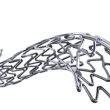Aortic stenosis (AS) is a common condition that shares risk factors with coronary artery disease. Many patients can suffer from both diseases simultaneously, something that increases the risk of acute myocardial infarction in the presence of aortic stenosis. AS can cause ischemia even in the absence of coronary artery disease, due to ventricular hypertrophy, increased<a href="https://solaci.org/en/2023/07/12/what-is-the-prognosis-of-an-acute-myocardial-infarction-in-the-presence-of-moderate-aortic-stenosis/" title="Read more" >...</a>
Aortic Stenosis and Cardiogenic Shock: Is TAVR an Option?
Cardiogenic shock (CS) in a setting of aortic stenosis is associated with high mortality rates. In consequence, surgery is generally not a possibility for this patient group, and they usually undergo aortic valvuloplasty, resulting in a mortality rate of 33%-50% at 30 days, 70% at one year, and 90% at two years. While transcatheter aortic<a href="https://solaci.org/en/2023/07/04/aortic-stenosis-and-cardiogenic-shock-is-tavr-an-option/" title="Read more" >...</a>
TAVI in Moderate Aortic Stenosis with Low Ejection Fraction
The presence of aortic stenosis, heart failure, and decreased ventricular function is associated with poor prognosis and high mortality. For this reason, both European and American guidelines classify severe stenosis as a Class I indication. There are two retrospective analyses that demonstrate the benefits of transcatheter aortic valve implantation (TAVI) via transfemoral access. The TAVR<a href="https://solaci.org/en/2023/06/16/tavi-in-moderate-aortic-stenosis-with-low-ejection-fraction/" title="Read more" >...</a>
Invasive vs Conservative Treatment in Patients with Spontaneous Coronary Artery Dissection
The prevalence of spontaneous coronary artery dissection (SCAD) is around 4% of acute coronary syndromes (ACS). Even though the current guidelines recommend a conservative approach, as long as it is clinically viable, it remain unclear whether there are benefits to percutaneous coronary intervention (PCI) as an initial approach, to prevent disease progression and adverse events.<a href="https://solaci.org/en/2023/06/14/invasive-vs-conservative-treatment-in-patients-with-spontaneous-coronary-artery-dissection/" title="Read more" >...</a>
Diffuse Coronary Artery Disease: One-Year 48mm XIENCE Skypoint Outcomes
Long 48mm Stent XIENCE Skypoint in the treatment of diffuse CAD Long coronary artery lesions often involve complex decision making since they can be treated either with a long stent or with shorter overlapping stents. Both in registries and meta-analysis, the overlapping technique has been associated to increased target vessel revascularization and increased radioscopy time,<a href="https://solaci.org/en/2023/06/08/diffuse-coronary-artery-disease-one-year-48mm-xience-skypoint-outcomes/" title="Read more" >...</a>
EuroPCR 2023 |Chimney Stenting vs BASILICA for the Prevention of Coronary Obstruction during TAVR
Coronary obstruction is a complication from TAVR that can cause death (up to 50% mortality), even though its incidence is lower than 1%. One of the most frequent strategies used in the prevention of this complication is chimney stenting in patients at high anatomical risk (valve in valve, narrow sinotubular junction, short coronary ostium height).<a href="https://solaci.org/en/2023/05/17/europcr-2023-chimney-stenting-vs-basilica-for-the-prevention-of-coronary-obstruction-during-tavr/" title="Read more" >...</a>
Coronary Angioplasty in Chronic Total Occlusions (CTO): Are There Sex Differences?
Studies and registries assessing sex differences in chronic total occlusions (CTO) are limited and women are under-represented, accounting for only 14%-21% of included patients. Even though success rate is comparable between sexes, several studies have shown higher complications rate among women. The aim of this study was to identify sex related baseline and procedural differences,<a href="https://solaci.org/en/2023/05/16/coronary-angioplasty-in-chronic-total-occlusions-cto-are-there-sex-differences/" title="Read more" >...</a>
Low Gradient Aortic Stenosis: Is Invasive Assessment Viable?
There is an important group of patients presenting low flow, low-gradient severe aortic stenosis (defined as mean gradient <40 mmHg). This is why we do dobutamine stress echocardiogram (DSE), to confirm whether we are dealing with truly severe aortic stenosis. However, it might not be well tolerated and a CT angiography will be done to<a href="https://solaci.org/en/2023/05/08/low-gradient-aortic-stenosis-is-invasive-assessment-viable/" title="Read more" >...</a>
Clinical Impact of Coronary Artery Disease on Results After TAVR
Coronary artery disease (CAD) coexists with aortic stenosis in about half the patients who suffer the latter. These patients receiving antiplatelet therapy are at a higher risk of periprocedural bleeding—one of the most frequent complications in patients who undergo transcatheter aortic valve replacement (TAVR). One way of limiting the risk for bleeding is choosing the<a href="https://solaci.org/en/2023/04/17/clinical-impact-of-coronary-artery-disease-on-results-after-tavr/" title="Read more" >...</a>
ISAR Score: Can We Predict the Need for Repeat PCI in DES Restenosis?
Score to predict the risk of repeat PCI in DES restenosis. With the use of drug eluting stents (DES) instent restenosis (ISR) has seen a significant reduction vs. bare metal stents (BMS) restenosis. The main cause of DES failure is ISR. This entity is difficult to manage because of its high recurrence and reintervention risk.<a href="https://solaci.org/en/2023/04/12/isar-score-can-we-predict-the-need-for-repeat-pci-in-des-restenosis/" title="Read more" >...</a>









